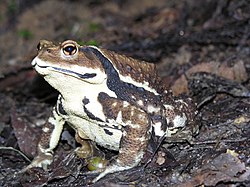蝦蟇
Jump to navigation
Jump to search
Chinese[edit]
| For pronunciation and definitions of 蝦蟇 – see 蛤蟆 (“frog; toad; tadpole; etc.”). (This term is a variant form of 蛤蟆). |
Japanese[edit]

Etymology 1[edit]
| Kanji in this term | |
|---|---|
| 蝦 | 蟇 |
| か > が Jinmeiyō |
ま Hyōgaiji |
| on’yomi | |
Appears to be borrowed from Middle Chinese 蝦蟇 (MC hae, “toad”, literally “shrimp, prawn + toad”).
Alternative forms[edit]
Pronunciation[edit]
Noun[edit]
- a toad
Usage notes[edit]
As with many terms that name organisms, this term is often spelled in katakana, especially in biological contexts (where katakana is customary), as ガマ.
Synonyms[edit]
Etymology 2[edit]
| Kanji in this term | |
|---|---|
| 蝦 | 蟇 |
| Jinmeiyō | Hyōgaiji |
| irregular | |
Appears to be a compound of 蟇 (gama, “toad”) + 蛙 (kaeru, “frog”). The kaeru changes to gaeru as an instance of rendaku (連濁). The kanji in this term are reversed as jukujikun (熟字訓) to match the Chinese spelling of the borrowed term gama (see above).
Pronunciation[edit]
Noun[edit]
蝦蟇 • (gamagaeru) ←がまがへる (gamagaferu)?
- a toad
References[edit]
Categories:
- Chinese disyllabic morphemes
- zh:Amphibians
- zh:Nicknames of individuals
- Chinese lemmas
- Mandarin lemmas
- Cantonese lemmas
- Gan lemmas
- Hakka lemmas
- Jin lemmas
- Eastern Min lemmas
- Teochew lemmas
- Wu lemmas
- Xiang lemmas
- Chinese nouns
- Mandarin nouns
- Cantonese nouns
- Gan nouns
- Hakka nouns
- Jin nouns
- Eastern Min nouns
- Teochew nouns
- Wu nouns
- Xiang nouns
- Chinese proper nouns
- Mandarin proper nouns
- Cantonese proper nouns
- Gan proper nouns
- Hakka proper nouns
- Jin proper nouns
- Eastern Min proper nouns
- Teochew proper nouns
- Wu proper nouns
- Xiang proper nouns
- Chinese terms with IPA pronunciation
- Chinese variant forms
- Japanese terms spelled with 蝦
- Japanese terms spelled with 蟇
- Japanese terms read with on'yomi
- Japanese terms borrowed from Middle Chinese
- Japanese terms derived from Middle Chinese
- Japanese terms with IPA pronunciation
- Japanese lemmas
- Japanese nouns
- Japanese terms with multiple readings
- Japanese terms spelled with jinmeiyō kanji
- Japanese terms spelled with hyōgaiji kanji
- Japanese terms written with two Han script characters
- Japanese terms with irregular kanji readings
- Japanese compound terms
- Japanese terms with rendaku
- Japanese terms spelled with jukujikun
